This article clarifies part of a previous discussion addressing discrimination against unattractive women.
We consider the problem of transforming the average English man and the average English woman via natural reproduction over multiple generations into individuals similar to those shown in the following picture, respectively. We disregard the desirability of this transformation.
Dorian Yates (left) and Elkie from Simonscans.
Let us specifically address the goal of producing masculine male offspring. For a given male input, which of the following two women appears more likely to produce masculine male offspring?
Alexa B. from Met Art (left) and Amiee Rickards from Mystique magazine.
Some more pictures of Amiee Rickards.
Similarly, for a given male input, which of the following two women appears more likely to produce masculine male offspring?
Adri (left) and Natasha (variously identified as Corinna from Met Art, Natalie from Domai, etc.).
The face of Adri.
Again, for a given male input, which of the following two women appears more likely to produce a tall, masculine son?
Alana from bestyoungbabes.com.
Leona from ATK galleria.
The intuitive answer to the three questions above is the more masculine-looking woman. However, since women will give birth to either male or female offspring, for a given male input, more masculine-looking women are less likely to produce feminine-looking female offspring. The three problems above can also be posed in terms of which of two men, one more masculine than the other, appears to be better suited to producing a more masculine son or more feminine daughter for a given female input. Once again, other things being equal, whereas more masculine men would tend to give birth to more masculine sons, they would also tend to give birth to more masculine daughters. Therefore, how can one naturally achieve the goal considered here? We consider numerous possible mating scenarios under the following assumptions:
The fertility of men increases, within limits, from below average masculinity to above average masculinity.
The fertility of women increases, within limits, from below average femininity to above average femininity.
In the table below, viability refers to the likelihood of a population thriving indefinitely.
# |
Mating preference |
Goal achievability and viability |
1. |
Individuals mate regardless of the masculinity-femininity of the partner. |
Our goal cannot be achieved. System not viable in the long run because people of reduced fertility -- i.e., masculinized women and insufficiently masculine men -- are no more preferred than fertile individuals. |
2. |
People prefer individuals having a comparable level of masculinity-femininity. In other words, masculine men mate with masculine women, effeminate men mate with feminine women, average men mate with average women. |
Our goal cannot be achieved. After all, masculine men and feminine women are pairing with less fertile partners, and the most fertile pairings involve average individuals who will produce offspring in the neighborhood of average – most will be average and a few will lean toward the masculine or feminine side. One could assume that a masculine male-masculine female pairing especially increases the likelihood of producing very masculine male offspring who could easily reproductively compensate for the low fertility of their masculine female siblings. However, consider the following relationship between body hairiness and masculine physical build in men. Starting from an effeminate physical build, as the physique becomes naturally more masculine, body hairiness increases, which appears intuitive, but beyond a certain point, greater body hairiness corresponds to a weaker physical build.
In other words, masculine male-masculine female pairings will not necessarily be leading to across-the-board very masculine male offspring. Undoubtedly, effeminate male-feminine female mating will also not guarantee that a female offspring will be feminine across the board. |
3. |
People prefer individuals having an opposite level of masculinity-femininity. In other words, more masculine men mate with more feminine women, less masculine men mate with more masculine women, average men mate with average women. |
Our goal cannot be achieved. Masculine male-feminine female pairings will tend to produce average offspring. On the other hand, this system is viable since the less fertile individuals are paired with each other. Offspring resulting from effeminate male-masculine female pairings would tend to lean toward average. |
4. |
Men, regardless of how masculine or feminine they are, typically prefer women with above average femininity. Women, regardless of how masculine or feminine they are, typically prefer men with above average masculinity. |
Our goal cannot be achieved, but compared to the other mating preference schemes, this scheme is likely to produce a greater proportion of masculine men and feminine women in the population. The system is also viable because most people have a preference for fertile partners. |
It should be obvious that the most viable mating preference schemes considered above are #3 and #4. Therefore, in a sexually reproducing species that has been thriving for a long time, one would expect to see few individuals with #1 and #2 mating preferences. Consider also that sexually reproducing species descend from asexually reproducing species. The problem of transforming a unisexual species to a species with two or more sexes requires a divergence that is similar to the divergence that is part of our goal, namely exaggerating the physical differences between the sexes, and it is clear that mating preference scheme #4 is best suited to the task. Therefore, mating preference scheme #4 will be a major tendency in humans and similar sexually reproducing species, a legacy of the origin of sexual dimorphism and sexual reproduction.
Note that the practical implementation of mating preference scheme #4 would be similar to that of mating preference scheme #3 on several counts. In mating preference scheme #4, masculine men and feminine women would be considered the most desirable on the part of most. Hence, masculine men will usually mate with feminine women, which translates to a) mostly leaving average men the option of selecting average to masculine women, and average men will prefer average to masculine women; b) mostly leaving average women the option of selecting average to effeminate men, and average women will prefer average to effeminate men; and c) leaving effeminate men and masculine women mostly the choice of each other. However, the difference from scheme #3 would be that in a number of cases, masculinized women will pursue and succeed in mating with masculine men even if they are not able to obtain masculine men as long-term partners, thereby increasing the likelihood that some of the resulting offspring are across-the-board very masculine men, but the resulting female offspring will tend to be masculine, too. Similarly, some not-so-masculine men will succeed in obtaining feminine women as a result of compensatory desirable characteristics (such as riches), thereby increasing the likelihood that some of the resulting offspring are across-the-board very feminine women, but the resulting male offspring would tend to be feminine, too.
The technical phrase describing the problem that prevents us from meeting our goal is sexually antagonistic selection, i.e., something that benefits one sex harms the other. In our example, above average femininity favors women but hurts men, and above average masculinity favors men but hurts women. There is no natural solution to this problem. A quest for feminine women and masculine men will invariably produce some masculine women and some feminine men in every generation. Under strong sexual selection, which can be conceptualized in terms of a strong push to meet our goal, whereas one would end up with a greater proportion of very masculine and very feminine women, one would also end up with a greater proportion of effeminate men and masculinized women, i.e., the average fertility of the general population would be somewhat diminished. Weaker sexual selection would translate to a lower proportion of very masculine men and very feminine women, but also a lower proportion of effeminate men and masculinized women, corresponding to a somewhat higher average fertility of the general population.
The last point can be clarified in light of asking the question what would be a good reproductive partner choice for a man picked at random? A good choice for a random male would be a woman that increases the likelihood of producing both male and female offspring with at least average fertility. This good choice cannot be a feminine woman because a random male could be effeminate and effeminate man plus feminine woman increases the likelihood of effeminate male offspring. The good choice cannot be a masculine woman either because if the randomly chosen man is masculine, masculine woman plus masculine man increases the likelihood of masculinized daughters. The good reproductive choice for a randomly chosen male is obviously a woman who is in the neighborhood of average with respect to the masculinity-femininity range; see some examples below.
Yana P. from Met Art (a more feminine version of Gisele Bundchen).
Yanka from Hegre Art.
In summary, since one cannot find a reproductive partner that simultaneously increases the likelihood of producing sons with above average masculinity and daughters with above average femininity, in general, a good reproductive partner is one that simultaneously increases the likelihood of producing average male and average female offspring. In this regard, feminine women would be a good reproductive choice for masculine men, but for the majority of men, a good reproductive choice would be an average woman and for some men a good reproductive choice would be a masculinized woman.
The purpose of this entry
This entry should hopefully clarify that this site isn’t arguing that feminine women are better, period.
The extreme contrast in the top picture was chosen to clarify the problem of sexually antagonistic selection and why mating preference scheme #4 above is a major tendency in the population. In reality, most women would consider the muscularity of the bodybuilder repulsive. However, by asking how one could make the sexes diverge, one considers a problem similar to the initial divergence leading to the sexes, and understands that mating preference scheme #4 is best suited to the task of increasing divergence whereas mating preference scheme #3 is best suited to the task of maintaining a given level of divergence. As noted earlier, the practical implementation of schemes #3 and #4 is broadly similar. Therefore, there will not be a strong push for scheme #3 to become a major tendency in the population; it will remain a minor tendency.
Some technical issues
Evidence showing that above average femininity in women corresponds to higher fecundity and fertility has been posted previously; see Fig. 3 on the “eating disorders” page and a study on estradiol and face shape in women. For evidence that below average masculinity in men corresponds to reduced fertility, see one example.
In the top picture, the male physique shown corresponds to high androgen and low estrogen levels, whereas the female physique corresponds to low androgen and high estrogen levels. If one considers the biosynthetic path of androgens and estrogens, one would note that estrogens (marked by red arrows in the figure below) are derived from androgens.
The biosynthetic paths of some steroids.
Testosterone levels in human males and females (left) and estradiol levels in human males and females.
Whereas the absence of testes eliminates a major source of androgens in women, more would be needed to produce feminine women than mere absence of testes. Genes that convert more of the androgens to estrogens will favor women whereas genes that convert less of the androgens to estrogens will favor men. Therefore, some of the molecular details underlying the problem of sexually antagonistic selection can be appreciated.
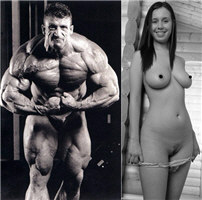



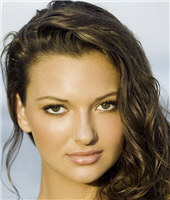
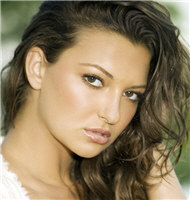

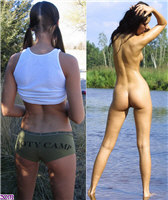













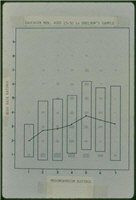













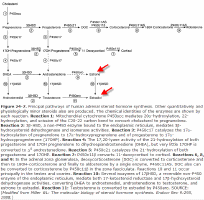
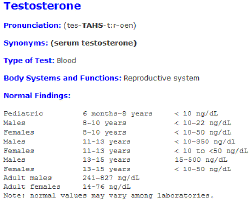
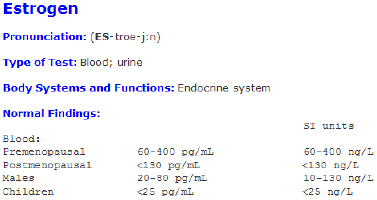
Comments
Erik: How do you decide if a face is masculine or feminine? Do you use an "I know it when I see it" system, or do you have objective criteria? On some parts of this website, you call a woman "obviously" masculine, but on other parts, you look at things like waist-to-hip ratio and various measurements related to the face. Do you use some kind of software to analyze a photograph, or do you just eyeball it? I know scientists have been investigating beauty by making direct measurements of people, or by photographing them under controlled conditions (fixed angles, facial expressions, and so on) but I can't see how to do it from a random photograph.
I ask because I'd like to be able to analyze some faces and bodies for myself. Is there some guide that defines what a "strong" jaw looks like, what "high" cheekbones look like, etc? I've heard that artists drawing human figures have manuals that tell them the size and shape of various body parts; do you use something like that?
Ashley: To decide whether a face is masculine or feminine upon inspection, you have to be familiar with population norms and variation. Go through the “feminine vs. masculine” page if you haven’t done so and look around this site. You should subsequently be able to describe why a face is masculine or feminine in reference to other faces just by looking at it, and this would not be subjective because of your ability to justify your description in reference to population norms and diversity.
Of course, you could measure face shape and show how two faces differ in shape using geometric morphometric methods if you wanted a rigorous analysis that cannot be faulted as subjective, but I wouldn’t bother with this unless I had to do it for a science paper.
Great site! I agree with everything you say.
By the way, what do you think of the Indian acress Mallika Sherawat? I can assure you she's all-natural.
Leroy: With respect to South Asian norms, Mallika Sherawat appears to have normal/average masculinity-femininity and above average attractiveness.
What do you think of Jeri Ryan Eric?
Elizabeth: I think Jeri Ryan looks decent and has a good physique. I am not a fan of her face though, especially her broad nose.
who cares? I bang what I think looks good, I donj't make charts about it first...
"People prefer individuals having a comparable level of masculinity-femininity. In other words, masculine men mate with masculine women, effeminate men mate with feminine women, average men mate with average women."
Yes, Erik, you are effeminate, this is why you like such "feminine" women. Way to hit the nail on the head.
huh?
Your a hilarious new addition to this site :)
I disagree with that statement but if Erik says that then we must assume he is very feminine? even more than me!
Well, Erik was just using that statement as an example not fact. I took it out of context to make fun of him a little bit.
Why do men have nipples?
This is interesting, but doesn't it kind of divert from one of the points of your site being that "lifetime" heterosexual males will overwhelmingly choose the hyperfeminine women? This entry makes a whole lot of sense and explains why some men like randomly less feminine things than others (I know men who think bigger than small breasts are repulsive, for example, even if they are aesthetically proportionate and pleasing to most), and therefore that heterosexual men can indeed be fully attracted to masculine women as compared to feminine women and that beauty really DOES somewhat vary in the eye of the beholder, although a result of science.
And by this are you in essence saying that on average an effeminate male is going to be more attracted to a masculine female? This is the main point I got, although I also got that you're saying they may just end up with that female because that's all they can get, so to speak. Or is it that you're just not sure, and these are two different but both plausible possibilities?
Maybe on average femininity has increased in the population, in both males and females. You had at least one page I've seen on all the ancestors known of homosapien and how we have become more "childlike" looking (forgot the term for this), especially as you see northern europeans having been forced to be more sexually selective due to harsh cold weather conditions. Maybe most men do prefer the hyperfeminine women, so those hypermasculine men (due to attractiveness- (though it's been disputed that many women prefer these men if at all only during ovulation, and more feminine men as mates, from what I've read)) will mate with the most feminine and thereby most attractive women they can get, but so will the hyperfeminine men- and some WILL be able to, due to other factors (wealth, power, force). In places like Northern Europe where many men died due to harsh conditions, the hypermasculine women were probably bred out because there were usually no men left to "settle" for them, and in turn the population on average became more feminine, although the men didn't become exceedingly feminine because they still needed the strength to hunt and do other hard, laborious tasks. So therefore, the extent of femininity a person can actually be would have a threshold, or maximum point, due to environmental pressures.
Also, I have read that hyperfeminine men tend to have less and slower moving sperm, and coupled with a hypermasculine woman's increased fertility problems, may have limited their reproduction (although of course this is much less limiting in today's society, due to various forms of fertility treatments).
I don’t wish to address this directly to Peter the clown and ignoramus since I don’t want him to respond, but the type of comment he left above is not welcome here. He said, “… but if Erik says that then we must assume …” There is no reason for the if and the comment based on this if when he could have just read what I have written. People shouldn’t bother commenting without reading and understanding the argument.
Box: You asked why do men have nipples? Species with two or more sexes descend from species with a single sex. This means that the sexes are derived from the modification of a basic design. Nipples are part of this basic design.
Natasha: I am not simply saying that an effeminate male is going to be more attracted to a masculine woman. The possibilities I discussed are various scenarios evaluated in light of how well they can achieve the goal mentioned in the beginning. None can achieve the goal, but the most successful will be scenario #4. Scenario #4, or the majority of men (including effeminate, normal and masculine) preferring above average femininity in women (not hyperfemininity as you have stated since there is an upper limit to which femininity remains attractive), is expected to be a much more common tendency than scenario #3 (people preferring individuals having an opposite level of masculinity-femininity). The prevalence of scenario #3 would be difficult to discern since without some investigation it will not be clear that an effeminate man-masculinized woman pairing is a matter of preference or limited choice, but there are reasons to believe that it will be a less-important-than-#4 tendency, but a tendency nevertheless, in mate choice.
So the argument remains that most men prefer above average femininity in the looks of women (and not necessarily the same level of femininity exaggeration; see example).
I didn’t say that we have become more child-like (in our faces). Compared to ancestral species, modern humans have become more child-like in the size of their adult face, but not shape (which is a new development).
Very masculine women have not been bred out in Northern Europe. The article discusses the phenomenon known as sexually antagonistic selection, one consequence of which is that no matter how hard we try to naturally make women more feminine and men more masculine, every generation will see its share of effeminate men and masculinized women. Under intense sexual selection that is directed toward exaggerating secondary sexual characteristics or making men look more masculine and women look more feminine, the proportion of individuals with various problems, including reduced fertility, such as effeminate men, masculine women, hypermasculine men and hyperfeminine women will increase such that the average fertility of the population is reduced (though given enough time, other selective forces could restore the average fertility to what it was).
Some people have a difficult time understanding that it is certainly possible for Northern Europe to simultaneously disproportionately have the most feminine-looking European women, have more feminine looking women on average and also disproportionately the most masculine-looking European women. Stronger sexual selection tends to do things like this for a while, the example here being the women more feminine-looking on average (shifting the average), the women being overrepresented among the very feminine (partly because of shifting of the average and partly because of greater dispersion around the mean) and the women being overrepresented among the very masculine (because of greater dispersion around the mean). But given enough time, selective forces could take care of the greater dispersion around the mean and the more strongly sexually selected population could end up with more feminine-looking women on average, women overrepresented among the very feminine and women underrepresented among the very masculine.
All this largely refers to the physique/morphology of the body (masculine or feminine) and NOT facial attractiveness. The morphology of the body is a direct primary result of androgen:estrogen ratios, HOWEVER, unlike the body, steroids do not exert much influence on how facially attractive a face is, hence why you can get women/men who appear facially attractive despite being masculinsed or femininised.
A good example of this is illustrated at the beautycheck.de website, where on the page entitled 'Social Perception', there are three pictures classed as 'unattractive female faces'. They are feminine and not masculinised, yet do appear to be particulary attractive.
Link:
http://www.uniregensburg.de/Fakultaeten/phil_Fak_II/Psychologie/Psy_II/beautycheck/english/sozialewahrnehmung/sozialewahrnehmung.htm
yet do NOT appear to be particulary attractive.
I daresay you're probably not reading this old thread any more, but I can't resist commenting anyway. I've read a lot of the site and it has some interesting ideas and good stuff, but this post makes no sense to me as somebody interested in evolutioanry theory and I think you've made an erroneous presumption, if I've understood the article correctly; that is that feminine women will have feminised offspring etc. That is, feminisation or masculisation applies to both sex offspring. I don't think sexual dimorphism works that way.
Instead, consider (for simplicity) two genomes in the population. Type A responds strongly to sexual development hormones, Type B responds weakly. The result of Type A is strongly gendered phenotypes. The result of Type B is weakly gendered phenotypes. That is, Type B genomes result in masculised girls and feminised boys; but what they actually are is less dimorphic; they are closer to an androgenous middle. That, I would argue, is what your masculised girls and feminised boys are. They are less gendered; less dimorphic.
It is then easily possible for strong sexual dimorphism to develop under natural selection, as appears to have happened to us since we split from chimps (who are weakly dimorphic compared to us). Strongly gendered phenotypes will be higher status in the society (we care a *lot* about attractiveness as a species) and mate together; their strongly dimorphic genomes will produce more of the same. Butch boys, girlie girls. If feminised women produced less masculine boys, they're dooming their own offspring to lower status and reproductive success. It would evolutionary suicide. If feminine women and masculine men have strongly dimoprhic genomes that produce feminine girls and masculine boys, then our system works.
Trying to think up an example, I thought of Schwarzenegger, who is *very* masculised with his massive lantern jaw etc. What pictures I can find of his daughters they do not appear masculised, they are rather attractive. THey are not *very* feminised though; then I took a look at Maria Shriver- and she's actually rather masculised facially at least. So that would explain not very girly daughters. Whatever, the daughters do not look like Arnie with his massive jaw etc. They're not masculised.
Anyway, if I am correct, couples featuring a very masculised father and very feminised mother should produce strongly dimorphic children. It would be nice to see a study of that.
Krizalid: It is incorrect that steroids do not affect facial attractiveness. Sex steroids/hormones shape masculine-feminine facial features, and femininity is strongly related to attractiveness in women. This contention is not refuted by showing examples of unattractive feminine faces since femininity is not the sole determinant of attractiveness. The majority of attractive women are feminine. Conversely, a much greater proportion of feminine women are attractive than non-feminine women.
Ian B.: I did not argue that feminized women will have feminized offspring, but that they will tend to have more feminine offspring. The actual outcome will depend on who has fathered the offspring, but other things being the same, the tendency would be to have more feminine offspring. Regarding your statement—“If feminised women produced less masculine boys, they're dooming their own offspring to lower status and reproductive success. It would evolutionary suicide”—you forget that lowered reproductive success of their male offspring would be matched by greater reproductive success of their female offspring.
You have also stated that masculinized girls and feminized boys are less gendered/less dimorphic. This is true of some, not of all. Sometimes you will find women with an effectively high level of sex steroids and you will observe thick bones, a well-developed musculature and exaggerated feminine curves, a very different look from the less gendered appearance typical of high-fashion models. Similarly, you will find men who may have an effeminate physique but other features that are normally masculine and even hypermasculine.
Your genetic model is not applicable; you find it tempting because you think it easily accounts for why humans can be more sexually dimorphic than an ancestral species (which is not quite correct, as the comparison varies depending on which feature is compared and which sub-species is considered). Feminine women pairing with masculine men will lead to feminine daughters and masculine sons when secondary sexually characteristics, the topic being visually illustrated in the article, are shaped by genes that have opposite effects on the sexes. Whereas the latter could be true with respect to some features, there is no way it is going to be true for a large number of features that are affected by quantitative trait loci.
Why should a lantern jaw (as a young adult) in Arnold Schwarzenegger make us conclude that he is a very masculine man? The latter would be a reasonable inference if there were corroboration from other parts of his face. However, if you look at his profile view, you will notice alveolar prognathism (protruding mouth region) and nasal bones that are not so prominent, both nowhere close to highly masculine looking for central Europeans. Similarly, his wife, Maria Shriver, has robusticity in her face that should not be confused with a high level of masculinization (consider her Irish background… you can look up the literature on more facially robust ethno groups in Ireland compared to other arrivals in Britain such as the Angles, the Saxons, the Norse, etc.).
Erik, I am a little perplexed as to what you mean by your terms. A feminised girl is by definition more dimorphic (that is, distant from an androgynous mean) than a less feminised girl. IF we take an example of say robustness of jawline, the more dimorphic girls will have less robust jawlines, which are feminine by definition. The boys have more robust jaws, and are masculised, and more dimorphic. Feminised/masculised and "dimorphic" are just synonyms. They mean the same.
When a (genetically controlled) feature is dimorphic it means that it varies in some way between male and female. If it is inherited equally by either gender, it is not a masculine/feminine feature. It's just a feature. Like, hair colour. "Redhead" is not a gender attribute, and is not dimorphic. If the same gene produced redder hair in girls and less red hair in boys it would be; and then sexual selection could select for it. But if it doesn't, it's no use in sexual selection. So we're interested in genes that differ in effect in boys and girls.
If your thesis were correct, then there would be no phenotypical dimorphism. Mate choice becomes irrelevant. A couple will have (on average) equal numbers of boys and girls. If choosing a male with a robust jaw will give both boys and girls a robust jaw, then any advantage of the increased attractiveness the boys have is negated by the ugliness of the girls. There is thus no point for the female to choose less or more robust jawed males. She can't improve the survival of her genes by doing so. What she gains on the swings, she loses on the roundabouts. She can have precisely the same genetic success by picking mates (in terms of "masculine features") entirely at random.
But then neither will sexual dimorphism be selected for. There's no point to it. Nobody can gain advantage or disadvantage with dimoprhic features. Since our species is strongly dimorphic, we can be sure that has not been the case. Robust males marry gracile females, and have robust sons and gracile daughters. If they don't, sexual dimorphism will rapidly vanish in the population and androgyny will rule. Your position is tantamount to saying that busty women will have busty sons, and bearded men will have bearded daughters. That clearly isn't the case.
Ian B.: What do I mean by “my terms”? Perhaps a visual illustration will help. If less feminine women are closer to an androgynous mean, what mean is the following woman—exaggerated feminine curves, thick bones and well-developed muscles—closer to or more distant from?
http://hiphopvideomodels.net/amazinAmie/home.html
It is hardly the case that selecting a masculine man is pointless to women if the possible benefits to male offspring are negated by possible negative outcomes in female offspring. The masculine man will tend to be more dominating and thus in a better position for resource acquisition and leadership, thereby having more opportunities for inseminating women. Thus any reduced fertility in female offspring can potentially be overcompensated for by the chances of male offspring growing up to be more successful with women. Of course, if there is the risk that a masculine man is more likely to be a cad than a dad, a woman always has the opportunity to marry (or form a pair bond) with a less masculine man but have her children fathered by more masculine men. In addition, men who can develop into healthy adults under extreme conditions (in our case an extreme sex hormone profile) also have some overall good genetics. So there are plenty of reasons for women to favor having children by healthy men with above average masculinity even though there is the potential downside that the female offspring born from such men will tend to be less feminine.
My position does not amount to bearded men having bearded daughters. The daughters of bearded men are going to develop under far lesser androgen levels because they will not have testes. Similarly, the sons born to busty women are not going to have female busts because they will not have ovaries.
Please read the literature on sexually antagonistic selection. The problems that constitute this phenomenon co-exist with sexual dimorphism and sexual selection.